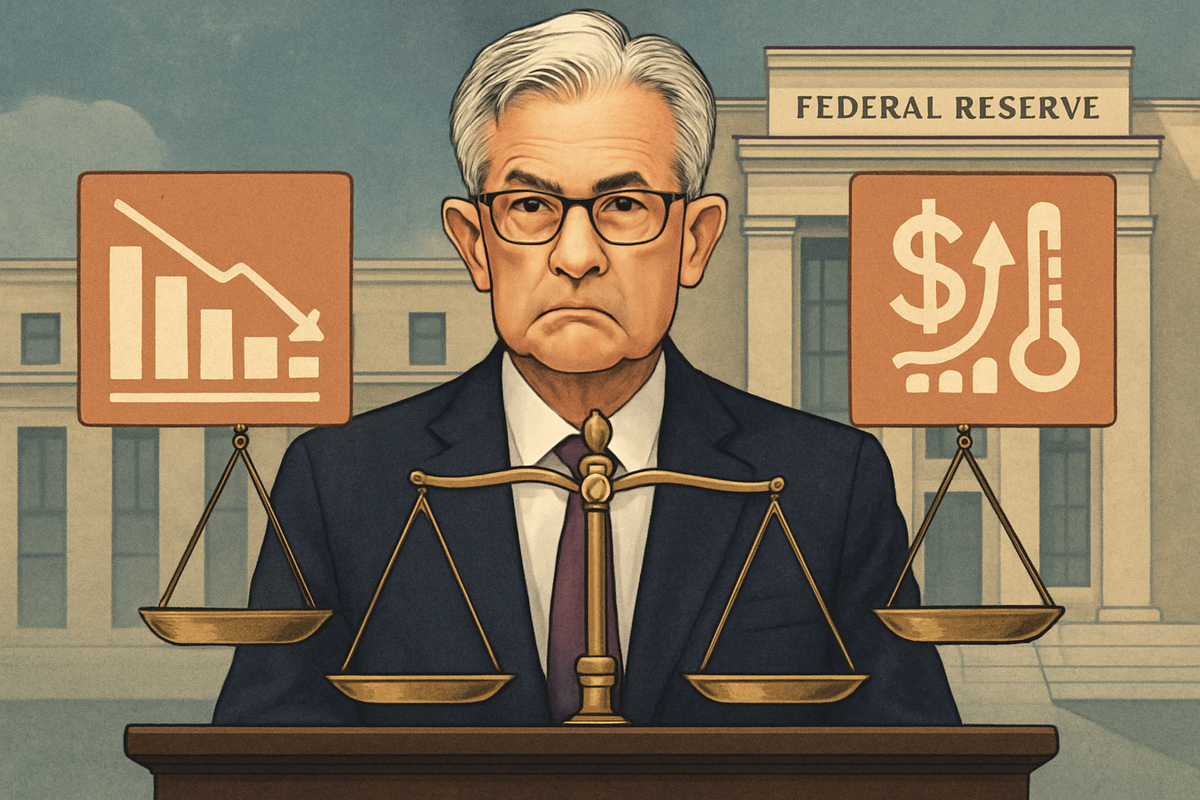Powell's Pivot: Fed Signals Further Rate Cuts Amidst Alarming Hiring Slowdown and Dual Mandate Tension

Federal Reserve Chair Jerome Powell has recently solidified expectations for further interest rate cuts, signaling a significant pivot in the central bank's monetary policy. This shift comes in response to a discernible slowdown in U.S. hiring and the increasing "tension" between the Fed's dual mandate of controlling inflation and fostering maximum employment. With a 0.25 percentage point cut already enacted in September 2025, Powell's latest remarks underscore a growing concern for the labor market's health, suggesting that the Fed is now leaning towards employment support, even as inflation remains somewhat elevated due to specific factors.
The implications of this policy trajectory are profound for financial markets and the broader economy. Investors are recalibrating their portfolios to account for a lower interest rate environment in 2025, impacting everything from bond yields to corporate earnings forecasts. This delicate balancing act by the Fed, navigating persistent inflation risks against a weakening job market, sets the stage for a period of cautious optimism and strategic adjustments across various sectors.
Fed Shifts Gears: Employment Concerns Drive Monetary Policy Reassessment
The Federal Reserve, under Chairman Jerome Powell, has demonstrably shifted its monetary policy stance from an aggressive inflation-fighting posture to one increasingly focused on mitigating risks to the U.S. labor market. This pivot was clearly telegraphed starting in late 2024 and culminated in a significant interest rate cut in September 2025, with further reductions now firmly on the horizon. The central bank's actions and rhetoric reflect a growing apprehension about the sustainability of job growth and the potential for a more severe economic downturn.
The initial strong signal came during the Jackson Hole Economic Symposium on August 23, 2024, where Powell declared, "The time has come for policy to adjust," citing diminished upside risks to inflation and increased downside risks to employment. He specifically highlighted a "cooling in labor market conditions" and emphasized the Fed's disinterest in further weakening of the job market. This guidance was met with immediate positive reactions from investors, leading to a rise in major stock indexes. The policy adjustment became concrete on September 17, 2025, when the Federal Open Market Committee (FOMC) lowered the federal funds rate by 0.25 percentage points to 4.0%-4.25%. Powell characterized this as a "risk management cut," directly aimed at preventing a further labor market slowdown. He pointed to an "edged up" unemployment rate, "slowed" job gains, and "risen" downside risks to employment, despite acknowledging that inflation remained "somewhat elevated," largely due to tariffs.
Further reinforcing this stance, Powell articulated the "challenging situation" at the Greater Providence Chamber of Commerce on September 23, 2025, describing a scenario where "near-term risks to inflation are tilted to the upside and risks to employment to the downside." He underscored that when the dual mandate goals are "in tension," the Fed must balance both sides, and the "increased downside risks to employment have shifted the balance of risks" guiding policy. Most recently, on October 14, 2025, speaking at the National Association for Business Economics (NABE), Powell issued a stark warning about a "sharp slowdown in hiring," identifying it as a "growing risk to the U.S. economy." He cited alternative private-sector data and internal Fed research to confirm a cooling labor market, with payroll gains slowing sharply due to factors like lower immigration and labor force participation. These remarks on October 14, 2025, solidified expectations for additional rate cuts, leading to a rally in U.S. Treasuries as investors priced in weaker economic growth, while the S&P 500 (SPX) recovered slightly.
The key players in this unfolding scenario are Federal Reserve Chair Jerome Powell and the broader Federal Open Market Committee, whose collective decisions dictate the nation's monetary policy. The timeline of events, spanning from Powell's influential Jackson Hole speech in August 2024 to the recent rate cut and subsequent reinforcing statements in October 2025, illustrates a methodical and increasingly urgent response to evolving economic indicators. Initial market reactions have generally been characterized by a positive sentiment towards the prospect of lower borrowing costs, although the release of September FOMC minutes in early October 2025 saw a slight tempering of expectations for rapid successive cuts, indicating a nuanced interpretation of the Fed's commitment to both mandates.
Corporate Fortunes: Winners and Losers in a Shifting Monetary Landscape
The Federal Reserve's dovish pivot, characterized by anticipated rate cuts and a heightened focus on employment, will inevitably reshape the fortunes of public companies across various sectors. While lower borrowing costs generally stimulate economic activity, the underlying concerns about a slowing economy and persistent inflation create a complex environment where certain industries are poised to thrive, while others may face significant headwinds.
Technology and Growth Stocks are among the primary beneficiaries of a lower interest rate environment. Companies in this sector, often reliant on external funding for aggressive expansion and innovation, will see their cost of capital decrease. This makes it cheaper to finance research and development, new product launches, and mergers and acquisitions, thereby boosting their valuations by increasing the present value of future cash flows. Giants like Microsoft (NASDAQ: MSFT), with its strong cloud computing (Azure) and AI positions, and NVIDIA (NASDAQ: NVDA), a leader in AI and graphics processors, stand to gain from cheaper capital for their own investments and increased IT spending by customers. Even Apple (NASDAQ: AAPL), a consumer electronics leader, could see enhanced consumer spending on premium devices, though a broader economic slowdown might temper this.
The Real Estate and Homebuilding sectors are also set for a significant uplift. Lower interest rates directly translate to reduced mortgage rates, making homeownership more accessible and stimulating demand. This directly benefits major homebuilders such as D.R. Horton (NYSE: DHI) and PulteGroup (NYSE: PHM). Commercial real estate, including Real Estate Investment Trusts (REITs) like Public Storage (NYSE: PSA), will also find borrowing for acquisitions and development more affordable, potentially kick-starting transaction volumes, particularly in the multifamily market. Similarly, Utilities like NextEra Energy (NYSE: NEE) and Duke Energy (NYSE: DUK), which are highly capital-intensive, will see their financing costs for critical infrastructure projects and renewable energy investments significantly reduced, improving their margins and enabling further growth.
Conversely, some sectors are likely to face considerable challenges. Financials, particularly traditional banks, could experience pressure. While investment banks might see increased capital market activity, universal banks like JPMorgan Chase (NYSE: JPM) and Bank of America (NYSE: BAC) may suffer from compressed net interest margins (NIMs)—the difference between what they earn on loans and pay on deposits—as rates fall. Furthermore, a slowing economy and potential increase in unemployment could lead to higher loan defaults and credit losses, impacting their profitability.
Consumer Discretionary companies are also vulnerable. Businesses offering non-essential goods and services, such as luxury items, travel, and dining out, are highly sensitive to consumer confidence and disposable income. A slowdown in hiring and job security concerns, coupled with inflation eroding purchasing power, will likely lead to reduced spending on discretionary items. Companies like Tesla (NASDAQ: TSLA), which benefits from lower auto loan rates but faces headwinds from reduced consumer confidence in big-ticket purchases, Starbucks (NASDAQ: SBUX), and Royal Caribbean Cruises (NYSE: RCL) could see demand wane as consumers tighten their belts. Even Industrials like Caterpillar (NYSE: CAT) and Boeing (NYSE: BA), while benefiting from cheaper capital for projects, could face reduced global demand and persistent inflation in input costs, offsetting some of the advantages of lower rates.
Wider Implications: A Global Ripple Effect and Historical Echoes
The Federal Reserve's pivot towards interest rate cuts, primarily driven by a weakening labor market and the inherent tension in its dual mandate, carries profound wider significance, reshaping not just domestic but also global economic landscapes. This strategic shift underscores a crucial juncture where the central bank is prioritizing employment stability even as inflation, albeit partly tariff-driven, remains a concern.
This dovish turn is expected to fuel several broader industry trends. Lower borrowing costs will generally stimulate investment and consumer spending, potentially reinvigorating sectors like private housing and construction. Equity markets have already responded with a "risk-on" sentiment, pushing major indices higher, particularly for growth stocks and rate-sensitive sectors. Concurrently, U.S. Treasury yields have declined, reflecting expectations of lower future rates and increased demand for fixed-income assets. Non-yielding assets like gold and silver have also seen a boost, touching new highs, as monetary easing typically supports precious metals as hedges against currency devaluation. Furthermore, the loosening of financing conditions is anticipated to stimulate deal activity in private assets, as well as the IPO and M&A markets, creating a more dynamic environment for corporate restructuring and growth.
The ripple effects extend globally, impacting competitors and partners worldwide. A dovish Fed generally leads to a weakening U.S. dollar, which makes American exports more competitive and benefits U.S.-based multinational corporations in global markets. This also eases pressure on emerging market currencies and dollar-denominated debt, potentially attracting capital inflows and fostering growth in developing economies, thereby creating new opportunities for foreign partners while intensifying competition for established players. This U.S. policy shift is also part of a broader global trend, with several other central banks either contemplating or actively pursuing monetary easing in response to decelerating growth. However, these monetary intentions are unfolding amidst escalating U.S.-China trade tensions, with new sanctions and export curbs from Beijing reigniting fears of economic retaliation and a global slowdown, which could overshadow the positive impacts of monetary easing.
From a regulatory and policy perspective, the ongoing U.S. government shutdown poses a significant challenge by delaying crucial official economic data, such as jobs reports and the Consumer Price Index. This forces the Fed to rely on alternative indicators and private-sector figures, increasing uncertainty for policymakers and investors alike. Despite the pivot, the Fed maintains its commitment to a strict 2% inflation target, a revision from its earlier "flexible average inflation targeting" framework, emphasizing a careful balance with employment goals. Furthermore, Chairman Powell has hinted at potentially stopping the reduction of the Fed's balance sheet (quantitative tightening), signaling a more accommodative stance aimed at ensuring ample liquidity. Historically, the Fed continually navigates this dual mandate, with past periods of significant monetary policy shifts combined with escalating trade conflicts often leading to heightened market volatility. The current situation draws parallels with historical attempts at achieving a "soft landing"—curbing inflation without triggering a recession—a feat rarely accomplished successfully. While not as extreme as the Volcker era's aggressive rate hikes to combat double-digit inflation, the current "risk management cuts" reflect a proactive measure to prevent a more significant employment slowdown, echoing past efforts to support the economy during downturns, such as after the 2008 financial crisis and the COVID-19 pandemic.
What Comes Next: Navigating a Path of Uncertainty and Opportunity
The path ahead for the U.S. economy and global financial markets will be largely dictated by the Federal Reserve's continued actions and the evolving interplay of employment data and inflationary pressures. In the short term, further interest rate cuts in late 2025 are highly anticipated, with market participants closely watching upcoming FOMC meetings for confirmation and the pace of easing. The Fed's explicit focus on mitigating risks to the labor market suggests a willingness to prioritize employment stability, potentially even at the cost of slightly higher-than-target inflation in the near term, especially if the current slowdown in hiring intensifies.
For businesses, this environment necessitates strategic pivots. Companies in rate-sensitive sectors, such as real estate and technology, may find opportunities for expansion and refinancing at lower costs, potentially boosting investment and innovation. However, a slowing economy, even with lower rates, could temper consumer demand, requiring businesses to adapt their sales strategies and focus on efficiency. Consumer discretionary companies, in particular, may need to brace for continued cautious spending. Long-term possibilities hinge on whether the Fed can engineer a "soft landing"—a challenging scenario where inflation is brought under control without triggering a severe recession. A successful soft landing would see a gradual recovery in the labor market and sustained economic growth, albeit at a potentially slower pace than in previous boom cycles.
Potential market opportunities may emerge in growth-oriented equities, particularly those with strong balance sheets and innovative products, as cheaper capital makes future earnings more attractive. Fixed-income markets will likely see continued demand for U.S. Treasuries, while precious metals and potentially cryptocurrencies could act as hedges against currency debasement and inflation. Conversely, challenges include managing persistent inflationary pressures, especially if supply chain disruptions or geopolitical tensions exacerbate cost increases. Investors will also need to navigate the inherent volatility that accompanies significant monetary policy shifts and a potentially slowing global economy. Potential scenarios range from a successful soft landing, characterized by mild growth and controlled inflation, to a more challenging environment with a mild recession if the labor market deteriorates more rapidly than anticipated, or if inflation proves more stubborn.
Comprehensive Wrap-up: A Balancing Act for Economic Stability
Federal Reserve Chair Jerome Powell's recent signals for further interest rate cuts mark a pivotal moment in U.S. monetary policy, underscoring the central bank's shifting priorities towards bolstering a weakening labor market. The core takeaway is the Fed's proactive stance in addressing a sharp slowdown in U.S. hiring, even while navigating the persistent "tension" between its dual mandate of achieving maximum employment and maintaining price stability. The September 2025 rate cut was a clear indicator of this shift, with further cuts expected in the coming months of 2025.
Moving forward, the market will be closely assessing economic data, particularly employment figures and inflation metrics, to gauge the Fed's next moves. Investors should remain attentive to the nuances of Powell's statements, as the central bank aims to strike a delicate balance. Sectors like technology, real estate, and utilities are poised to benefit from lower borrowing costs, while traditional banks and consumer discretionary companies may face headwinds from compressed margins and reduced consumer spending. The wider significance of this pivot extends to global markets, impacting the U.S. dollar, emerging economies, and the broader trajectory of international monetary policy.
The lasting impact of this period will depend on the Fed's ability to successfully navigate the current economic complexities. A well-executed series of rate cuts could stabilize the labor market and support a gradual economic recovery, potentially avoiding a deeper downturn. However, the inherent risks of persistent inflation and unforeseen economic shocks remain. Investors should watch for continued clarity from the Fed regarding its inflation target, any further adjustments to its balance sheet policy, and the trajectory of key economic indicators. The coming months will be crucial in determining whether Powell's pivot successfully guides the U.S. economy towards a more stable and prosperous future, or if it merely delays a more significant reckoning.
This content is intended for informational purposes only and is not financial advice
More News
View More




Recent Quotes
View More
Quotes delayed at least 20 minutes.
By accessing this page, you agree to the Privacy Policy and Terms Of Service.